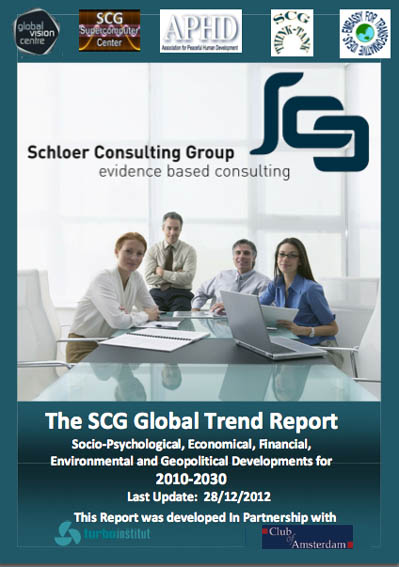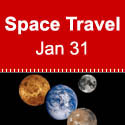
Content
Uploaded e-crews for interstellar missions
Next Event: the future of Space Travel
Joy Rides and Robots are the Future of Space Travel
Club of Amsterdam blog
News about the Future
5 Future Technology Innovations from IBM
Recommended Book: Space Chronicles: Facing the Ultimate Frontier
Results of the 10 Years Club of Amsterdam event
Welcome to the Club of Amsterdam Journal.
The 10 Years Club of Amsterdam event was an inspiring experience – please check out the videos, photos, the Public Brainstorm, …!
“In spite of the opinions of certain narrow-minded people, who would shut up the human race upon this globe, as within some magic circle which it must never outstep, we shall one day travel to the moon, the planets, and the stars, with the same facility, rapidity, and certainty as we now make the voyage from Liverpool to New York!” – Jules Verne
“Our sun is one of 100 billion stars in our galaxy. Our galaxy is one of billions of galaxies populating the universe. It would be the height of presumption to think that we are the only living things in that enormous immensity.” – Wernher von Braun. His crowning achievement was to lead the development of the Saturn V booster rocket that helped land the first men on the Moon in July 1969.
Join us at our next event about the future of Space Travel – Thursday, January 31, 18:30 – 21:15!
Felix F Bopp, Founder & Chairman
Uploaded e-crews for interstellar missions

By Giulio Prisco/KurzweilAI
Giulio Prisco is transhumanism editor for KurzweilAI. He is a science writer, technology expert, futurist, and transhumanist.
The awesome 100 Year Starship (100YSS) initiative by DARPA and NASA proposes to send people to the stars by the year 2100 — a huge challenge that will require bold, visionary, out-of-the-box thinking.
There are major challenges. “Using current propulsion technology, travel to a nearby star (such as our closest star system, Alpha Centauri, at 4.37 light years from the Sun, which also has a a planet with about the mass of the Earth orbiting it) would take close to 100,000 years,” according to Icarus Interstellar, which has teamed with the Dorothy Jemison Foundation for Excellence and the Foundation for Enterprise Development to manage the project.
“To make the trip on timescales of a human lifetime, the rocket needs to travel much faster than current probes, at least 5% the speed of light. … It’s actually physically impossible to do this using chemical rockets, since you’d need more fuel than exists in the known universe,” Icarus Interstellar points out.

Artwork: The bright star Alpha Centauri and its surroundings (credit: ESO)
So the Icarus team has chosen a fusion-based propulsion design for Project Icarus, offering a million times more energy compared to chemical reactions. It would be evolved from their Daedalus design.
This propulsion technology is not yet well developed, and there are serious problems, such as the need for heavy neutron shields and risks of interstellar dust impacts, equivalent to small nuclear explosions on the craft’s skin, as the Icarus team states.
Although Einstein’s fundamental speed-of-light limit seems solid, ways to work around it were also proposed by physicists at the recent 100 Year Starship Symposium.

Daedalus concept (credit: Adrian Mann)
However, as a reality check, I will assume as a worse case that none of these exotic propulsion breakthroughs will be developed in this century.
That leaves us with an unmanned craft, but for that, as Icarus Interstellar points out, “one needs a large amount of system autonomy and redundancy. If the craft travels five light years from Earth, for example, it means that any message informing mission control of some kind of system error would take five years to reach the scientists, and another five years for a solution to be received.
“Ten years is really too long to wait, so the craft needs a highly capable artificial intelligence, so that it can figure out solutions to problems with a high degree of autonomy.”
If a technological Singularity happens, all bets are off. However, again as a worse case, I assume here that a Singularity does not happen, or fully simulating an astronaut does not happen. So human monitoring and control will still be needed.
The mind-uploading solution
The very high cost of a crewed space mission comes from the need to ensure the survival and safety of the humans on-board and the need to travel at extremely high speeds to ensure it’s done within a human lifetime.
One way to overcome that is to do without the wetware bodies of the crew, and send only their minds to the stars — their “software” — uploaded to advanced circuitry, augmented by AI subsystems in the starship’s processing system.
The basic idea of uploading is to “take a particular brain [of an astronaut, in this case], scan its structure in detail, and construct a software model of it that is so faithful to the original that, when run on appropriate hardware, it will behave in essentially the same way as the original brain,” as Oxford University’s Whole Brain Emulation Roadmap explains.
It’s also known as “whole brain emulation” and “substrate-independent minds” — the astronaut’s memories, thoughts, feelings, personality, and “self” would be copied to an alternative processing substrate — such as a digital, analog, or quantum computer.
An e-crew — a crew of human uploads implemented in solid-state electronic circuitry — will not require air, water, food, medical care, or radiation shielding, and may be able to withstand extreme acceleration. So the size and weight of the starship will be dramatically reduced.
Combined advances in neuroscience and computer science suggest that mind uploading technology could be developed in this century, as noted in a recent Special Issue on Mind Uploading of the International Journal of Machine Consciousness).
Uploading research is politically incorrect: it is tainted by association with transhumanists — those fringe lunatics of the Rapture of the Nerds — so it’s often difficult to justify and defend.

The connectome (credit: NIH Human Connectome Project)
Creating a brain
But MIT neuroscientist Sebastian Seung has speculated that if models of brains become increasingly accurate, eventually there must be a simulation indistinguishable from the original.
In Connectome: How the Brain’s Wiring Makes Us Who We Are, he explains how mapping the human “connectome” (the connections between our brain cells) might enable us to upload our brains into a computer.
In fact, “neuroscience is ready for a large-scale functional mapping of the entire neural circuits,” Harvard scientist George Church and other researchers conclude in a landmark 2012 Neuron paper.
I suggest that developing mind-uploading technology for software e-crews may make the 100YSS project practical, while delivering equally important spinoffs in neuroscience, computer science, and longevity, perhaps even including indefinite life extension.
The new brain can be much more resistant and long-lived than the old biological brain, and it can be housed in a similarly resistant and long-lived robotic body. Robots powered by human uploads can be rugged, resistant to the vacuum and the harsh space environment, easily rechargeable, and much smaller and lighter than wetware human bodies.
Eventually, human uploads augmented by AI subsystems can be implemented in the solid-state circuitry of the starship’s processing system.
Boredom and isolation will not be a problem for e-crew members, because the data processing system of a miniaturized starship will be able to accommodate hundreds and even thousands of human uploads.

Light sail concept (credit: NASA)
Light sails
The huge reduction in weight resulting from uploading would allow for radical propulsion systems, such as “light sails” (aka “solar sails”) — spacecraft driven by light energy alone. The Planetary Society currently has a research project to develop light sails.
The low mass of light sails — combined with the e-crew’s ability to withstand extreme acceleration — might allow for achieving a substantial fraction of the speed of light, so the time to go to the stars would be significantly reduced.
E-crewed interstellar missions have been described by science fiction writers. Greg Egan was one of first in Diaspora. In Charlie Stross‘ Accelerando, the coke-can-sized starship Field Circus, propelled by a Jupiter-based laser and a light sail, visits a nearby star system with an e-crew of 63 uploaded persons who have a hell of a lot of fun on the way.
Here we are, sixty something human minds. We’ve been migrated — while still awake — right out of our own heads using an amazing combination of nanotechnology and electron spin resonance mapping, and we’re now running as software in an operating system designed to virtualize multiple physics models and provide a simulation of reality that doesn’t let us go mad from sensory deprivation!
And this whole package is about the size of a fingertip, crammed into a starship the size of your grandmother’s old Walkman, in orbit around a brown dwarf just over three light-years from home.
Of course. a light sail powered by lasers back home, can only push a starship on an one-way trip, but the data from the uploaded astronauts would will be beamed home via the Interplanetary Internet.
The “starwisp” concept proposed by Robert L. Forward is a variation of a light sail remotely driven by a microwave beam instead of visible light (but has known problems).
Sideloading
One problem with implementing mind uploading is that it’s plagued by metaphysical discussions about the continuity of personal identity (“is only a copy”), which are irrelevant here. Even if I thought that uploads will be only copies, I would be not only happy, but also grateful and honored if my upload copy could participate in the first interstellar mission.
But even coarse, preliminary uploading technology could be sufficient. “Sideloading”, proposed by science fiction writer Greg Egan in Zendegi, is the process of training a neural network to mimic a particular organic brain, using a rich set of non-invasive scans of the brain in action.
Egan describes a “Human Connectome Project,” completed in the late 2020s, that produces detailed connectome maps from brain scans of thousands of volunteers. The maps could be used to build an average human neural network, which could serve as a model of a generic human brain.
Then the model could be tweaked and fine-tuned to emulate a specific living person, using in-vivo brain scans and supervised training sessions in a VR environment. In Zendegi, the resulting personalized model passes the Turing Test and often behaves as a convincing emulation of the original.
Why not send AI’s?
If strong AI is developed, perhaps smarter than humans, why should we bother to upload humans? One answer is that most of us will want human minds on our first journey to the stars.
However, I agree with Ray Kurzweil’s speculation that we will merge with technology, so many future persons will not be “pure” humans or pure AIs, but rather hybrids, blended so tightly that it will be impossible to tell which is which.
Ultimately, I think space will not be colonized by squishy, frail and short-lived flesh-and-blood humans. As Sir Arthur C. Clarke wrote in Childhood’s End, perhaps “the stars are not for Man” — that is, not for biological humans 1.0.
It will be up to our postbiological mind children, implemented as pure software based on human uploads and AI subsystems, to explore other stars and colonize the universe. Eventually, they will travel between the stars as radiation and light beams.
Next Event: the future of Space Travel

the future of Space Travel
Thursday, January 31, 2013
Location: Betty Asfalt Complex, Nieuwezijds Voorburgwal 282, 1012 RT Amsterdam
The conference language is English.
This event is supported by India House Amsterdam.
With
Gerard ‘t Hooft, Nobel Laureate from Utrecht University
Moving to Outer Space: Science and Science Fiction
Bas Lansdorp, Co-Founder & General Director, Mars One
Humans on Mars in 2023
Michel van Pelt, spaceflight engineer, author, ESA/ESTEC
Future Robotic Science and Exploration
Our Moderator is Job Romijn, bedenker, brainstormer, problem solver, artist. Club of Amsterdam Round Table




Joy Rides and Robots are the Future of Space Travel
By Eve Harding
Human space exploration has its roots in war. The Saturn rocket used to propel Neil Armstrong and Buzz Aldrin to the moon was based on the V2 rockets developed by Nazi Germany to pummel London during WWII. Furthermore, the space race was not a born out of a need to explore and expand human knowledge, but was more a technological showcase between the United States and Soviet Union during the cold war. However, we now live in more peaceful times. The cold war is over and it has been over forty years since a human being last walked on the Moon, and few scientists seriously believe we will be returning any time soon.
Manned space exploration
Manned space exploration is expensive, very expensive. NASA has a budget of over $17 billion a year, and the American Congress has agreed to fund the new Space Launch System (SLS), which is the most powerful rocket ever produced. While this is capable for the first time since the Apollo missions of sending humans beyond low-Earth orbit (where the International Space Station sits and where the Space Shuttle did all of its missions), this doesn’t mean we will be sending humans back to the Moon or beyond anytime soon.
For the last forty years, manned space travel has involved relatively short hops into low Earth orbit, with the Space Shuttle, Russian Soyuz and European Ariane rockets used mainly for putting communication satellites into orbit. Of course, this has improved our technology dramatically. Without space travel, life would be very different on Earth, especially when it comes to communications and telecoms. Mobile phones, satellite TV and GPS are all technologies that are owed to the space race, and few of us could imagine life without a smart phone, sat nav and the other communication devices we have come to rely on. Furthermore, these telecom satellites have made long distance calls and global communication much cheaper and simpler, and have created a much smaller world. Because of these communication satellites, the internet has flourished, providing us with such things as Google Earth, something unconceivable forty years ago. However, as useful as telecom satellites and the big changes they have made to communications are, there has been very little space exploration by humans. In fact, since the last man walked on the moon in 1972, no human has left low Earth orbit, and it doesn’t look like the future of space travel is going to involve humans doing much exploring at all.
Robot exploration
Setting foot on the Moon, Mars or other far off body, landing on the surface, and then returning home safely, costs far too much to be justifiable. However, that doesn’t mean that space exploration is over. While sending humans to far off bodies such as the Moon or Mars is very expensive, sending robots is much, much cheaper. After all, robots don’t need oxygen, food water and a comfortable temperature in order to survive. Furthermore, and perhaps more importantly, robots don’t have to be brought home, and a one-way ticket to Mars is much cheaper and technologically easier to do than a return trip.
In addition, while human exploration is inspiring and romantic, it isn’t that useful when it comes to scientific understanding. Advances in robotic technology means there are few things an astronaut can do in space that a robot can’t. The Mars Curiosity Rover, for instance, is a complete laboratory that can sample, analyse, and study the rocks and soil of the Martian surface. Furthermore, with its array of cameras, you don’t need human eyes on the surface to see the planet.
The stars and beyond
Even unmanned space exploration is still limited. While we can pretty much send a robot anywhere in the solar system, reaching to the stars is beyond our capabilities. The Voyager probes, for example, have been in space over 35 years, and yet are only just reaching the outer limits of our solar system. Travelling at 57,000 km/h, Voyager 1 is approximately 17 light hours from Earth, or put another way, in 35 years, Voyager 1 has travelled 0.2 light years. When you consider the nearest star, Alpha Proxima, is 4.2 light years way, it will be another 70,000 years before the satellite gets anywhere near.
However, travel to the stars is not beyond the realms of possible future technologies and is limited purely by propulsion. The problem is, the only method we have to propel a spacecraft at the moment is rocket power, and the big problem with that is how much fuel has to be carried for just a relatively short periods of propulsion (95% of Saturn 5 contained fuel, and 60% of this was burned in the first couple of minutes). However, if a propulsion system that is more economical is developed then travel to the stars within reasonable timescales, such as a couple of decades, is far more realistic, even considering the immense distance.
For example, the average family car has an acceleration force of 1 g. However, because of gravity, air pressure and friction, speed is limited on Earth. In space, none of these forces apply, so if an average family car could drive in space, it would keep on accelerating to immense speeds. In fact, if it had enough fuel, it would take less than three months for it to reach 50% of the speed of light, which would mean that Alpha Proxima was within reach within a decade of space flight (about the same amount of time as it currently tales a probe to reach Jupiter). Of course, no such propulsion system yet exists, but scientists believe they may not be that far away, which means in a few generations time, manmade robots could begin exploring planets in other solar systems, of which there are many, and return their signals within the lifetime of those that sent it.
Commercial space travel
Despite all this, humans will still have a place in the future of space travel, although it is going to be a much more local activity, and it probably won’t be through large organisations such as NASA. Commercial space travel is now a reality. Projects such as Virgin Galactic are already preparing to take tourists into space. While these trips are sub orbital, the demand from rich celebrities and wealthy business people mean it won’t be long before commercial enterprise starts to expand. Already, the cash strapped Russian Space Agency is preparing to take musical singer Sarah Brightman to the International Space Station, and more wealthy space tourists are bound to want to follow.
For the rest of us, space travel may seem like a dream. However, the same was said about the first jet airliners, but jumping on an airplane is something most people have done. While a visit to Mars, the Moon or planets beyond our solar system may never be a reality for us humans, in the future, a holiday in space may just become as common as flying abroad is today.
Club of Amsterdam blog

Club of Amsterdam blog
http://clubofamsterdam.blogspot.com
Joy Rides and Robots are the Future of Space Travel
The Transposon
10-step program for a sick planet
Public Brainstorm: Economic-Demographic Crisis
Public Brainstorm: Energy
Public Brainstorm: EnvironmentPublic Brainstorm:Food and WaterPublic Brainstorm: Overpopulation
News about the Future

A Report Card for Global Food Giants
The social and environmental policies of the world’s ten biggest food and beverage giants need a major shake-up, said international relief and development organization Oxfam America as it launched its new global campaign called ‘Behind the Brands’. The campaign was launched with new research that for the first time scores and ranks the agricultural policies, public commitments and supply chain oversight of Associated British Foods, Coca Cola, Danone, General Mills, Kellogg, Mars, Mondelez, Nestlé, Pepsico and Unilever.
The research reveals that the “Big 10” food and beverage companies – that together make $1 billion-a-day – are failing millions of people in developing countries who supply land, labor, water and commodities needed to make their products.
ABF (19%), Kellogg’s (23%) and General Mills (23%) scored most poorly. They have weaker policies than Coca-Cola (41%), Unilever (49%) and Nestle (54%) for example.
“While some companies are doing better than others, no company has passed the test,” said Raymond C. Offenheiser, President of Oxfam America.

World in 2050
A report by pwc
The BRICs and beyond: prospects, challenges and opportunitiesKey findings:
The world economy is projected to grow at an average rate of just over 3% per annum from 2011 to 2050, doubling in size by 2032 and nearly doubling again by 2050.
China is projected to overtake the US as the largest economy by 2017 in purchasing power parity (PPP) terms and by 2027 in market exchange rate terms. India should become the third ‘global economic giant’ by 2050, a long way ahead of Brazil, which we expect to move up to 4th place ahead of Japan.
Russia could overtake Germany to become the largest European economy before 2020 in PPP terms and by around 2035 at market exchange rates. Emerging economies such as Mexico and Indonesia could be larger than the UK and France by 2050, and Turkey larger than Italy.
Outside the G20, Vietnam, Malaysia and Nigeria all have strong long-term growth potential, while Poland should comfortably outpace the large Western European economies for the next couple of decades.
5 Future Technology Innovations from IBM
by IBM
The goal of cognitive computing is to get a computer to behave, think and interact the way humans do. In 5 years, machines will emulate human senses, each in their own special way.
Every year IBM makes predictions about 5 technology innovations that stand to change the way we live within the next 5 years.
Touch
In 5 years, you will be able to touch through your phone. IBM is working on bringing a sense of touch to mobile devices, and bringing together virtual and real world experiences for a number of industries including retail. Shoppers will be able to “feel” the texture and weave of a fabric or product by brushing their finger over the item’s image on a device’s screen.
Sight
In 5 years, computers will not only be able to look at images, but understand them. Computers will be trained to turn pictures and videos into features, identifying things like color distribution, texture patterns, edge information and motion information. A pixel will be worth a thousand words.
Hearing
In 5 years, computers will hear what matters. Hearing systems of the future will be trained by ‘listening’ to sounds and will use this input to start detecting patterns and building models to decompose sounds. Machines will be used to predict when a tree might fall or to translate “baby talk” so parents understand if a baby’s fussing indicates hunger, tiredness or pain.
Taste
In 5 years, a computer system will know what you like to eat better than you do. A machine that experiences flavor will determine the precise chemical structure of food and why people like it. Not only will it get you to eat healthier, but it will also surprise us with unusual pairings of foods that are designed to maximize our experience of taste and flavor. Digital taste buds will help you to eat smarter.
Smell
In 5 years, computers will have a sense of smell. We will see vast advances where sensors will be equipped to smell potential diseases that feed back into a cognitive system to tell us if they suspect a possible health issue. Your phone will detect if you’re coming down with a cold or illness before you do.
Recommended Book

Space Chronicles: Facing the Ultimate Frontier
By Neil deGrasse Tyson (Author), Avis Lang (Editor)
Neil deGrasse Tyson is a rare breed of astrophysicist, one who can speak as easily and brilliantly with popular audiences as with professional scientists. Now that NASA has put human space flight effectively on hold – with a five- or possibly ten-year delay until the next launch of astronauts from U.S. soil – Tyson’s views on the future of space travel and America’s role in that future are especially timely and urgent. This book represents the best of Tyson’s commentary, including a candid new introductory essay on NASA and partisan politics, giving us an eye-opening manifesto on the importance of space exploration for America’s economy, security, and morale. Thanks to Tyson’s fresh voice and trademark humor, his insights are as delightful as they are provocative, on topics that range from the missteps that shaped our recent history of space travel to how aliens, if they existed, might go about finding us
Results of the 10 Years Club of Amsterdam event
The 10 Years Club of Amsterdam event was an inspiring experience – please check out the videos, photos, the Public Brainstorm, …!
see event page for
Presentation
Public Brainstorm
Articles & Contributions
Photos
Videos
Hardy F. Schloer: 10-step program for a sick planet .
Hardy F. Schloer, Owner, Schloer Consulting Group — SCG, Advisory Board of the Club of Amsterdam.
Socratic Dialogue
Socratic Dialogue guided by Humberto Schwab, Philosopher, Owner, Humberto Schwab Filosofia SL, Director, Club of Amsterdam
and the panel
Huib Wursten, Senior Partner, ITIM International / Andrei Kotov, Business Planning Manager, Projects & Technology , Shell Upstream International / Jeanine van de Wiel, Group Leader Global Regulatory Affairs, DSM Food Specialties / Oebele Bruinsma, Founder & Partner, Synmind bv / Arjen Kamphuis, Futurist, Co-founder, CTO, Gendo / Hardy F. Schloer, Owner, Schloer Consulting Group – SCG, Advisory Board of the Club of Amsterdam
Video: Winston Nanlohy
The SCG Global Trend Report

Schloer Consulting Group: SCG Global Trend Report (Version December 2012) is free. You can order it by clicking here or by sending an email to info@schloerconsulting.com
Futurist Portrait: Nicholas Negroponte

Nicholas Negroponte delivering the Forrestal Lecture to the US Naval Academy in Annapolis, MD, on April 15, 2009
Nicholas Negroponte is founder and chairman of the One Laptop per Child non-profit association. He is currently on leave from MIT, where he was co-founder and director of the MIT Media Laboratory, and the Jerome B. Wiesner Professor of Media Technology. A graduate of MIT, Nicholas was a pioneer in the field of computer-aided design, and has been a member of the MIT faculty since 1966. Conceived in 1980, the Media Laboratory opened its doors in 1985. He is also author of the 1995 best seller, Being Digital, which has been translated into more than 40 languages.
Negroponte is an active angel investor and has invested in over 30 startup companies over the last 30 years, including Zagats, Wired, Ambient Devices, Skype and Velti. He sits on several boards, including Motorola (listed on the New York Stock Exchange) and Velti (listed on the NASDAQ and formerly on the London Stock Exchange). He is also on the advisory board of TTI/Vanguard. In August 2007, he was appointed to a five-member special committee with the objective of assuring the continued journalistic and editorial integrity and independence of the Wall Street Journal and other Dow Jones & Company publications and services. The committee was formed as part of the merger of Dow Jones with News Corporation. Negroponte’s fellow founding committee members are Louis Boccardi, Thomas Bray, Jack Fuller, and the late former Congresswoman Jennifer Dunn.
One Laptop Per Child program has distributed more than 2.5 million computers to children around the globe.
Nicholas: “Everybody agrees that whatever the solutions are to the big problems, they … can never be without some element of education.”
“We have delivered fully loaded tablets to two villages in Ethiopia, one per child, with no instruction or instructional material whatsoever… Within minutes of arrival, the tablets were unboxed and turned on by the kids themselves. After the first week, on average, 47 apps were used per day. After week two, the kids were playing games to race each other in saying the ABCs.”
Agenda
| Season Events 2012/2013 January 31, 2013 the future of Space Travel Location: Betty Asfalt Complex, Nieuwezijds Voorburgwal 282, 1012 RT Amsterdam Supported by India House Amsterdam  February 28, 2013 the future of Football Location: Amsterdam Supported by India House Amsterdam April 25, 2013 the future of Digital Identity or the death of Social Media as we know it. Location: Info.nl, Sint Antoniesbreestraat 16, 1011 HB Amsterdam [Next to Nieuwmarkt] Supported by Info.nl & Freelance Factory May 30, 2013 the future of Europe Location: Amsterdam In collaboration with the World Future Society Supported by India House June 27, 2013 the future of Urban Gardening Location: Geelvinck Museum, Keizersgracht 633, 1017 DS Amsterdam Supported by Geelvinck Museum |






Customer Reviews
Thanks for submitting your comment!